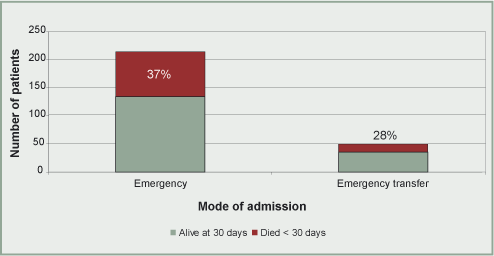Transfer of patients
There were 50 patients who were transferred as emergencies from one hospital to another. There have been concerns that in some circumstances the outcome for such patients could be worse, either because of adverse effects of the transfer process itself or because of the extra delay that is likely to accompany transfer. NCEPOD examined the outcome associated with patients that were transferred as opposed to those who were admitted directly to the hospital where the operation took place.
Figure 16. Outcome in emergency open repairs by whether patients were transferred n=264. Percentages refer to patients who died in hospital within 30 days.
There did not appear to be an adverse effect on outcome for patients who were admitted as an emergency transfer (Figure 16). NCEPOD collected information from the hospital where the operation took place, so has no data on whether any patients died during the transfer, nor whether the population of patients chosen to be transferred differed from the patients whom hospitals chose not to transfer out.
Variations in transfer policies may affect the survival of patients in different sized units. It is possible that smaller units may transfer the relatively stable patients to tertiary centres. Patients judged too unfit to be transferred would be managed in the smaller unit and would be likely to have a poor outcome with or without surgery.
Back to top
|

